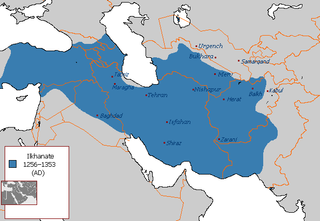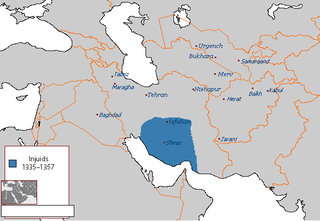Related Research Articles

The Ilkhanate, also spelled Il-khanate, known to the Mongols as Hülegü Ulus was a khanate established from the southwestern sector of the Mongol Empire, ruled by the Mongol House of Hulagu. Hulagu Khan, the son of Tolui and grandson of Genghis Khan, inherited the Middle Eastern part of the Mongol Empire after his brother Möngke Khan died in 1260. Its core territory lies in what is now part of the countries of Iran, Azerbaijan, and Turkey. At its greatest extent, the Ilkhanate also included parts of modern Iraq, Armenia, Georgia, Afghanistan, Turkmenistan, Pakistan, part of modern Dagestan, and part of modern Tajikistan. Later Ilkhanate rulers, beginning with Ghazan in 1295, converted to Islam. In the 1330s, the Ilkhanate was ravaged by the Black Death. Its last khan Abu Sa'id died in 1335, after which the khanate disintegrated.

The Chobanids or the Chupanids were descendants of a Mongol family of the Suldus clan that came to prominence in 14th century Persia. At first serving under the Ilkhans, they took de facto control of the territory after the fall of the Ilkhanate. The Chobanids ruled over Azerbaijan, Arrān, parts of Asia Minor, Mesopotamia, and west central Persia, while the Jalayirids took control in Baghdad.
Hasan Kuchak or Ḥasan-i Kūchik was a Chupanid prince during the 14th century. He is credited with setting up a nearly independent Chupanid state in northern Persia during the struggles taking place in the aftermath of the Ilkhanate.

The House of Inju was a dynasty of that came to rule over the Iranian cities of Shiraz and Isfahan during the 14th century. Its members became de facto independent rulers following the breakup of the Ilkhanate until their defeat in 1357.
Shaikh Hasan, called "Buzurg", was the first of several de facto independent Jalayirid rulers of Iraq and central Iran. He was the son of Husain and Öljetey. His sister Soyurghatmish Khatun was married to Öljaitü Khan.

Shaykh Uways Jalayir was the Jalayirid ruler of Iraq (1356–1374) and Azerbaijan (1360–1374). He was the son of Hasan Buzurg and the Chobanid princess Dilshad Khatun.

The Kart dynasty, also known as the Kartids, was a Sunni Muslim dynasty of Tajik origin closely related to the Ghurids, that ruled over a large part of Khorasan during the 13th and 14th centuries. Ruling from their capital at Herat and central Khorasan in the Bamyan, they were at first subordinates of Sultan Abul-Fateh Ghiyāṣ-ud-din Muhammad bin Sām, Sultan of the Ghurid Empire, of whom they were related, and then as vassal princes within the Mongol Empire. Upon the fragmentation of the Ilkhanate in 1335, Mu'izz-uddin Husayn ibn Ghiyath-uddin worked to expand his principality. The death of Husayn b. Ghiyath-uddin in 1370 and the invasion of Timur in 1381, ended the Kart dynasty's ambitions.

The Sarbadars were a mixture of religious dervishes and secular rulers that came to rule over part of western Khurasan in the midst of the disintegration of the Mongol Ilkhanate in the mid-14th century. Centered in their capital of Sabzavar, they continued their reign until Khwaja 'Ali-yi Mu'ayyad submitted to Timur in 1381, and were one of the few groups that managed to mostly avoid Timur's famous brutality.
Muhammad Khan was a claimant to the throne of the Ilkhanate.
Sati Beg was an Ilkhanid princess, the sister of Il-Khan Abu Sa'id (r. 1316–1333). She was the consort of amir Chupan (1319–1327), Il-Khan Arpa (r. 1335–36), and Il-Khan Suleiman (r. 1339–1343). In 1338–39, she was briefly the Ilkhanid khatun during internal conflicts, appointed by a Chobanid faction led by Hassan Kuchak.
Suleiman Khan was a Chobanid puppet for the throne of the Ilkhanate during the breakdown of central authority in Persia.
Malek Ashraf, was a Chupanid ruler of northwestern Iran during the 14th century. He was the last of the Chupanids to possess a significant influence within Persia. He was the son of Timurtash.

Togha Temür, also known as Taghaytimur, was a claimant to the throne of the Ilkhanate in the mid-14th century. Of the many individuals who attempted to become Ilkhan after the death of Abu Sa'id, Togha Temür was the only one who hailed from eastern Iran, and was the last major candidate who was of the house of Genghis Khan. His base of power was Gurgan and western Khurasan. His name "Togoy Tomor" means "Bowl/Pot Iron" in the Mongolian language.
Amir Vali was the ruler of Astarabad and parts of Mazandaran from 1356 until 1366, and again from c. 1374 until 1384. His relatively long reign was dominated by conflict with the Sarbadars and the Jalayirids, and ended only upon the arrival of Timur into eastern Persia.
Muhammad Aytimur was the leader of the Sarbadars of Sabzewar from 1343 until his death.
Khwaja Shams al-Din 'Ali was the leader of the Sarbadars of Sabzewar from 1348 until his death.
Lutf Allah was the leader of the Sarbadars of Sabzewar from 1356 until his death.
The Battle of Zava was fought on July 18, 1342 between the armies of the Sarbadars and the Kartids. Since their appearance as a political force in Khorasan, the Sarbadars had fought to expand their influence in north-eastern Iran and defend against the forces of the claiming Ilkhan Togha Temür who sought to regain Khorasan. Mu'izz al-Din Husain, the chief of the Kartids of Herat, recognized Togha Temur's overlordship, and when the Sarbadars secured their hold on Khorasan they sought to eliminate the Kartid threat to the east.
Hasan II, also known as Fakhr al-Dawla Hasan, was the last ruler of the Bavand dynasty from 1334 to 1349. He was the brother, and successor of Sharaf al-Muluk.
References
- Roemer, H. R. "The Jalayirids, Muzaffarids and Sarbadars." The Cambridge History of Iran Volume 6: The Timurid and Safavid Periods. Edited by Peter Jackson. New York: Cambridge University Press, 1986. ISBN 0-521-20094-6
- Smith, Jr., John Masson. The History of the Sarbadar Dynasty 1336-1381 A.D. and Its Sources. The Hague: Mouton, 1970. ISBN 90-279-1714-0
| Preceded by 'Abd al-Razzaq | Head of the Sarbadars 1338/9–1344 | Succeeded by Muhammad Aytimur |